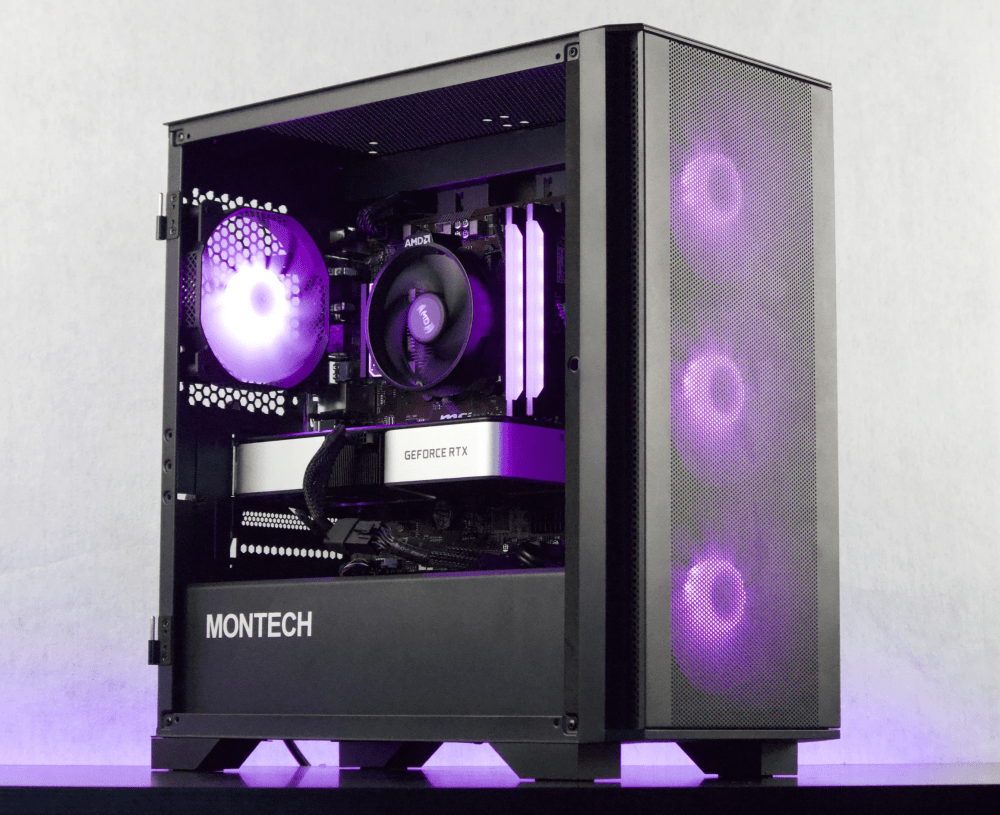Welcome to our blog post on understanding refresh rate on a monitor! If you've ever wondered about the technical details behind the smooth visuals on your screen, then this post is for you. Refresh rate is an essential aspect of monitor performance that directly impacts your visual experience, especially when it comes to gaming, video playback, and overall image quality.
In this article, we will delve into the concept of refresh rate, its significance in different scenarios, and how you can check and change the refresh rate on your monitor. So, whether you're a casual user, a hardcore gamer, or a multimedia enthusiast, read on to gain a better understanding of this crucial monitor feature.
The Importance of Refresh Rate in Monitors:
-
Impact on Visual Performance: Refresh rate refers to the number of times a monitor updates its display per second, measured in Hertz (Hz). A higher refresh rate translates to smoother motion, reduced motion blur, and an overall enhanced visual experience. We'll explore how this affects different aspects of your monitor usage.
-
Significance in Gaming: For gamers, refresh rate is a critical factor in achieving a responsive and immersive gaming experience. Higher refresh rates allow for smoother gameplay, reduced input lag, and improved clarity during fast-paced action. We'll discuss the different refresh rate options available for gaming monitors and their benefits.
-
Effect on Video Playback and Streaming: When it comes to watching videos or streaming content, refresh rate plays a significant role in delivering smooth and fluid motion. We'll explore how different refresh rates impact video playback quality and the viewing experience.
How to Check Refresh Rate on Your Monitor:
To help you understand and optimize your monitor's refresh rate, we'll guide you through the process of checking it on different operating systems. Whether you're using Windows, MacOS, or Linux, we've got you covered with step-by-step instructions.
Understanding Different Refresh Rates:
Not all monitors offer the same refresh rate options. We'll explain the differences between common refresh rates, such as 60Hz, 120Hz, 144Hz, and 240Hz monitors. You'll learn about their advantages, limitations, and which one might be the best fit for your specific needs.
How to Change the Refresh Rate on Your Monitor:
Finally, we'll walk you through the process of changing the refresh rate on your monitor. We'll provide detailed instructions for Windows, MacOS, and Linux, so you can optimize your monitor settings and make the most out of your visual experience.
In conclusion, understanding refresh rate is crucial for maximizing the performance of your monitor. Whether you're a gamer, a content creator, or a casual user, knowing how to check and adjust your monitor's refresh rate can significantly improve your visual experience. So, let's dive into the world of refresh rates and unlock the full potential of your monitor! Stay tuned for our upcoming articles on monitor technology and optimization tips.
Introduction: What is Refresh Rate?
Refresh rate refers to the number of times a monitor updates its display per second. It is measured in Hertz (Hz), indicating how many times the screen refreshes in one second. The refresh rate determines how smooth and fluid the visuals appear on the screen.
In simpler terms, refresh rate is the frequency at which new images are displayed on the monitor. Each image displayed is known as a frame, and the refresh rate determines how many frames are shown per second. A higher refresh rate means that more frames are displayed, resulting in smoother motion and reduced motion blur.
To put it into perspective, imagine watching a video that has a low frame rate. The motion appears choppy and less lifelike because there are fewer frames being displayed per second. On the other hand, a high refresh rate can make even fast-paced action appear incredibly smooth and seamless.
Refresh rate is an essential aspect of monitor performance, particularly for activities that involve motion, such as gaming and watching videos. It directly impacts how visually appealing and immersive your experience is while interacting with your computer or other display devices.
In the next sections, we will explore the significance of refresh rate in different scenarios, such as gaming and video playback, and provide you with practical tips on how to check and change the refresh rate on your monitor. By the end of this article, you will have a comprehensive understanding of refresh rate and how it affects your overall visual experience. So, let's dive in!
The Importance of Refresh Rate in Monitors
Refresh rate plays a crucial role in determining the overall visual performance of a monitor. It directly affects how smoothly and fluidly images and motion are displayed on the screen. Understanding the importance of refresh rate is key to appreciating its impact on different aspects of monitor usage. Let's explore its significance in detail:
-
Impact on Visual Performance: The refresh rate of a monitor significantly affects the overall visual experience. A higher refresh rate means that the monitor can refresh the display more frequently, resulting in smoother motion and reduced motion blur. This is particularly noticeable when viewing fast-paced content or engaging in activities that involve rapid motion, such as gaming or watching action movies.
-
Significance in Gaming: For gamers, refresh rate is of utmost importance. A higher refresh rate allows for more frames to be displayed per second, resulting in smoother gameplay and improved responsiveness. This is particularly beneficial for fast-paced games where quick reactions are necessary. Gamers often opt for monitors with refresh rates of 120Hz or higher to enjoy a more immersive and fluid gaming experience.
-
Effect on Video Playback and Streaming: When it comes to watching videos or streaming content, refresh rate also plays a significant role. A higher refresh rate can make the motion in videos appear smoother and more natural. It reduces the blurring effect that can occur during fast-moving scenes, enhancing the overall viewing experience. However, it's important to note that the content being watched must be compatible with the monitor's refresh rate for optimal results.
-
Reduction of Eye Strain: A higher refresh rate can also help reduce eye strain, particularly during extended periods of computer use. When the screen refreshes at a faster rate, there is less flickering, which can cause eye fatigue and discomfort. This is especially beneficial for individuals who spend long hours working or gaming on their computers.
-
Compatibility with Graphics Processing Units (GPUs): It's important to consider the compatibility between the refresh rate of your monitor and the capabilities of your graphics processing unit (GPU). To fully utilize the benefits of a high refresh rate monitor, your GPU should be able to deliver the necessary frames per second (FPS) to match the monitor's refresh rate. If the GPU cannot keep up, the advantages of a high refresh rate may not be fully realized.
In conclusion, understanding the importance of refresh rate is essential for choosing a monitor that meets your specific needs. Whether you're a gamer seeking a more immersive experience, a multimedia enthusiast looking for smoother video playback, or simply someone who wants to reduce eye strain during computer use, the refresh rate plays a significant role in enhancing your overall visual performance.
How to Check Refresh Rate on Your Monitor
Checking the refresh rate on your monitor is a simple process that can be done on different operating systems. Whether you're using Windows, MacOS, or Linux, we'll guide you through the steps to determine the refresh rate of your monitor. Let's explore the methods for each operating system:
Checking Refresh Rate on Windows:
-
Right-click on the desktop and select "Display settings" from the context menu.
-
In the Display settings window, scroll down and click on "Advanced display settings."
-
Under the Advanced display settings, click on "Display adapter properties for [your monitor name]."
-
In the properties window, navigate to the "Monitor" tab.
-
Look for the "Screen refresh rate" section. The refresh rate value will be displayed here.
Checking Refresh Rate on MacOS:
-
Click on the Apple menu in the top-left corner of the screen and select "System Preferences."
-
In the System Preferences window, click on "Displays."
-
Navigate to the "Display" tab.
-
Hold down the Option key on your keyboard and click on the "Scaled" button.
-
A list of available resolutions and refresh rates will appear. The currently selected refresh rate will be highlighted.
Checking Refresh Rate on Linux:
-
Open the system settings menu. The exact steps may vary depending on the Linux distribution and desktop environment you're using.
-
Look for the "Display" or "Monitor" settings.
-
In the display settings, you should be able to find the refresh rate of your monitor listed.
By following these steps, you can easily check the refresh rate of your monitor on different operating systems. Having this information will allow you to understand the capabilities of your display and make informed decisions when it comes to optimizing your visual experience. Remember, the refresh rate is measured in Hertz (Hz) and indicates the number of times the screen refreshes per second.
In the next sections, we'll explore the different refresh rates available and how they impact your monitor's performance in various scenarios.
Understanding Different Refresh Rates
Understanding the different refresh rates available for monitors is essential for selecting the right display for your specific needs. Let's explore the most common refresh rates and their implications:
60Hz Monitors:
A 60Hz monitor is the most common and widely used refresh rate. It means that the display refreshes 60 times per second. While this is considered the standard, it may not be ideal for certain applications that involve fast motion, such as gaming or watching action-packed movies. However, for general computer use, web browsing, and casual content consumption, a 60Hz monitor can provide a satisfactory visual experience.
120Hz Monitors:
A 120Hz monitor doubles the refresh rate compared to a 60Hz monitor. This means that the display refreshes 120 times per second. The higher refresh rate allows for smoother motion and reduced motion blur, making it particularly beneficial for gaming and watching fast-paced content. Gamers often prefer 120Hz monitors as they offer a more responsive and immersive gaming experience.
144Hz Monitors:
A 144Hz monitor further increases the refresh rate, offering even smoother motion and reduced input lag compared to lower refresh rate displays. It refreshes the screen 144 times per second. This higher refresh rate is highly sought after by gamers who value fluidity and responsiveness in their gameplay. It can provide a significant advantage, especially in fast-paced competitive games.
240Hz Monitors:
240Hz monitors offer one of the highest refresh rates currently available in the consumer market. Refreshing the screen 240 times per second, these monitors provide the smoothest motion and the lowest input lag. While the difference between 144Hz and 240Hz may not be as noticeable to everyone, professional gamers and enthusiasts who demand the utmost performance and responsiveness often opt for 240Hz monitors.
It's important to note that while higher refresh rates can enhance visual performance, they require more powerful hardware to deliver the necessary frames per second (FPS) to match the refresh rate. When selecting a monitor, ensure that your graphics processing unit (GPU) can support the desired refresh rate to fully maximize its benefits.
In the next sections, we'll guide you through the process of changing the refresh rate on your monitor, allowing you to optimize your display settings and tailor them to your preferences and requirements.
How to Change the Refresh Rate on Your Monitor
Changing the refresh rate on your monitor is a straightforward process that can be done through the display settings of your operating system. Here's a step-by-step guide on how to change the refresh rate on Windows, MacOS, and Linux:
Changing Refresh Rate on Windows:
-
Right-click on the desktop and select "Display settings" from the context menu.
-
In the Display settings window, scroll down and click on "Advanced display settings."
-
Under the Advanced display settings, click on "Display adapter properties for [your monitor name]."
-
In the properties window, navigate to the "Monitor" tab.
-
Look for the "Screen refresh rate" section and click on the drop-down menu. You will see a list of available refresh rates supported by your monitor.
-
Select the desired refresh rate from the list and click on "Apply."
-
A dialog box will appear asking if you want to keep the new settings. Click on "Keep changes" to confirm the new refresh rate.
Changing Refresh Rate on MacOS:
-
Click on the Apple menu in the top-left corner of the screen and select "System Preferences."
-
In the System Preferences window, click on "Displays."
-
Navigate to the "Display" tab.
-
Hold down the Option key on your keyboard and click on the "Scaled" button.
-
A list of available resolutions and refresh rates will appear. Select the desired refresh rate from the list.
-
Close the System Preferences window to apply the new refresh rate.
Changing Refresh Rate on Linux:
-
Open the system settings menu. The exact steps may vary depending on the Linux distribution and desktop environment you're using.
-
Look for the "Display" or "Monitor" settings.
-
In the display settings, you should find an option to change the refresh rate. Click on the drop-down menu and select the desired refresh rate from the available options.
-
Save the changes to apply the new refresh rate.
By following these steps, you can easily change the refresh rate on your monitor according to your preferences and requirements. Remember to select a refresh rate that is supported by your monitor and ensure that your graphics card can handle the increased demands of higher refresh rates.
Optimizing the refresh rate can greatly enhance your visual experience, especially for gaming and fast-motion content. Experiment with different refresh rates to find the one that offers the best balance between smoothness and performance for your specific needs.
Congratulations! You now have a comprehensive understanding of refresh rate, its importance, how to check it, and how to change it on your monitor. Armed with this knowledge, you can take full control of your visual experience and make the most out of your display. Enjoy smoother motion, reduced motion blur, and an enhanced visual performance!
Looking to upgrade your monitor? Check out Jawa for killer deals on new and used displays.





